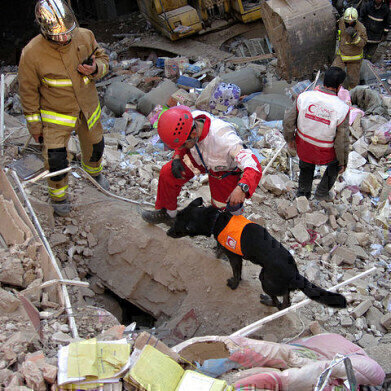Bioanalytical
The Changing Smell of Death — Chromatography Investigates
Mar 18 2016
When disaster strikes and humans are trapped beneath piles of rubble — it is a race against time to locate and rescue survivors. Trauma, blood loss and dehydration are amongst the dangers affecting a trapped person’s chances of survival. The first 72 hours after a disaster are critical in finding survivors — with the survival rate of victims declining after 48 hours.
Sniffing out humans
To help find survivors — or bodies — search and rescue (SAR) teams have access to a wide range of technology. Thermal and infrared cameras, microphones to listen for sounds of life and geophones are used when looking for evidence of people. But the most effective method is often to deploy man’s best friend — a highly trained SAR dog — because it can cover a large amount of ground relatively quickly.
There are two main types of dogs used by SAR teams — human scent dogs which are trained to find living victims and human remains detection dogs which are trained to find human remains. The search strategy and length of time from disaster onset can determine which dogs are used.
Dogs smell the volatile organic compounds (VOCs) given off by humans — something we do all the time — when they want to find or track them. But each person has a slightly different odour — otherwise police dogs would be running round in circles as they tracked a suspect — based on many factors including genetics, diet and lifestyle. Dogs are usually trained to detect the odour of expired air, blood or urine of victims trapped or buried under debris.
Post-mortem decomposition profiling
But sometimes the rescue teams cannot help and people die — and currently, little research has been carried out to analyse the way the VOC profile changes post-mortem. A team from the University of Technology Sydney has set out to change this. They measured the VOC decomposition profile of pigs — a useful human analogue for these studies — and found what they describe as a substantial transition in VOC profile around 43 hours after death, research described in the journal Heliyon.
Taking samples over a three day period, the team identified 105 different VOCs using two-dimensional gas chromatography coupled with time-of-flight mass spectrometry (GC×GC-TOFMS) — a technique with many bioanalytical uses as discussed in the article, A Multi-Platform Approach for Metabolomic Analysis of Human Liver Tissues.
The team suggest that human scent dogs would be more useful for the first day after any disaster — but that in the second day and beyond, dogs trained in searching for human remains could be a useful addition. The papers authors state that:
The results of this study provide new information about the transition of VOCs soon after death and particularly during the timeframe when disaster response is critical. With repeat analyses, such information can inform USAR teams on the optimal use of detector dogs to locate victims, both alive and deceased, following a mass disaster.
Image from Wikimedia commons
Digital Edition
Chromatography Today - Buyers' Guide 2022
October 2023
In This Edition Modern & Practical Applications - Accelerating ADC Development with Mass Spectrometry - Implementing High-Resolution Ion Mobility into Peptide Mapping Workflows Chromatogr...
View all digital editions
Events
Apr 23 2024 Kintex, South Korea
Apr 23 2024 Seoul, South Korea
Apr 28 2024 Montreal, Quebec, Canada
May 05 2024 Seville, Spain
May 15 2024 Birmingham, UK














